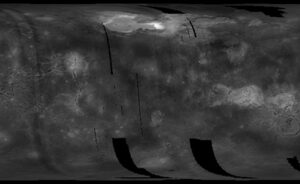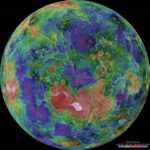
 In the height of space travel, NASA decided to set up a mission to take pictures of Venus. The planet is always shrouded in a layer of clouds, with an extremely thick carbon dioxide atmosphere. When looking at Venus in visible light, those clouds are all you would see. That said, even a “flyby” would not give a good view of the planet, plus it would take a long time to get there, so it wasn’t feasible for a manned mission. Nevertheless, a mission was set up in March of 1988, for the purpose of “checking it out.” It was announced by NASA that astronauts Walker, Grabe, Lee, Thagard, and Cleave would be the crew of the STS-30 mission to release the Magellan spacecraft for the flight planned for late April 1989. Thagard had flown twice before, on STS-7 in June 1983 and the STS-51B Spacelab 3 mission in April-May 1985. Walker, Grabe, and Cleave had each flown once before, on STS-51A, STS-51J, and STS-61B, respectively. STS-30 would be Lee’s first trip into space. Walker and Thagard joined NASA in the astronaut class of 1978, Grabe and Cleave joined in 1980, and Lee in 1984. The mission would take four days, during which they would deploy Magellan and its Inertial Upper Stage (IUS) on the first flight day. There was a 29-day window for the deployment of Magellan, as dictated by the alignments of Venus and Earth to achieve the proper trajectory for the journey to its destination. Once it was released, their job, as far as Magellan was essentially over.
In the height of space travel, NASA decided to set up a mission to take pictures of Venus. The planet is always shrouded in a layer of clouds, with an extremely thick carbon dioxide atmosphere. When looking at Venus in visible light, those clouds are all you would see. That said, even a “flyby” would not give a good view of the planet, plus it would take a long time to get there, so it wasn’t feasible for a manned mission. Nevertheless, a mission was set up in March of 1988, for the purpose of “checking it out.” It was announced by NASA that astronauts Walker, Grabe, Lee, Thagard, and Cleave would be the crew of the STS-30 mission to release the Magellan spacecraft for the flight planned for late April 1989. Thagard had flown twice before, on STS-7 in June 1983 and the STS-51B Spacelab 3 mission in April-May 1985. Walker, Grabe, and Cleave had each flown once before, on STS-51A, STS-51J, and STS-61B, respectively. STS-30 would be Lee’s first trip into space. Walker and Thagard joined NASA in the astronaut class of 1978, Grabe and Cleave joined in 1980, and Lee in 1984. The mission would take four days, during which they would deploy Magellan and its Inertial Upper Stage (IUS) on the first flight day. There was a 29-day window for the deployment of Magellan, as dictated by the alignments of Venus and Earth to achieve the proper trajectory for the journey to its destination. Once it was released, their job, as far as Magellan was essentially over.
STS-30 lifted off on May 4, 1989, utilizing space shuttle Atlantis, which was on its third space flight. Of course, STS-30 lifted off from NASA’s Kennedy Space Center (KSC) in Florida. Its five-person crew included Commander David M Walker, Pilot Ronald J Grabe, and Mission Specialists Mark C Lee, Norman E Thagard, and Mary L Cleave. They flew a four-day mission that deployed the Magellan spacecraft, which was then managed by NASA’s Jet Propulsion Laboratory in Southern California, to study Venus. This mission would unite NASA’s human and interplanetary spaceflight programs. It also marked the first US planetary launch since 1978. The astronauts successfully deployed Magellan and its upper stage on their first day in space, sending the spacecraft off on its 15-month journey to Venus. I can imagine that it was an exciting venture for them.
Once Magellan arrived at the cloud-shrouded planet, it spent four years mapping Venus in unprecedented detail. The mission vastly increased human knowledge of the planet. The Magellan spacecraft arrived at Venus on August 10, 1990. Using radar imaging, Magellan began its primary goal of mapping the surface of Venus. The radar imaging was able to “peek” through the thick clouds which made visual observation difficult. While there, Magellan made the first global map of the surface of Venus and global maps of the planet’s gravity field. It was inserted into a near-polar elliptical orbit and continued its mission for several years. After its journey to Venus, the Magellan spacecraft, finally arrived at Venus in 1990. It then made the first global map of the surface of Venus as well as global maps of the planet’s gravity field. NASA was quite surprised at the findings 
 Magellan produced, including the fact that it had a relatively young planetary surface that was probably formed by lava flows from planet-wide volcanic eruptions. After completing its four-year flight mission, NASA deliberately plunged the Magellan spacecraft to the surface of Venus in October 1994 to gather data on the planet’s atmosphere before it ceased operations. It marked the first time an operating planetary spacecraft had been intentionally crashed.
Magellan produced, including the fact that it had a relatively young planetary surface that was probably formed by lava flows from planet-wide volcanic eruptions. After completing its four-year flight mission, NASA deliberately plunged the Magellan spacecraft to the surface of Venus in October 1994 to gather data on the planet’s atmosphere before it ceased operations. It marked the first time an operating planetary spacecraft had been intentionally crashed.


Leave a Reply